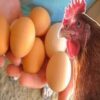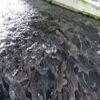Within the heart of a cowpea flower lies a remarkable structure known as the ovary. This seemingly simple chamber plays a pivotal role in the plant’s reproductive success, housing the female reproductive organs and nurturing the development of future cowpea seeds.
The cowpea ovary is situated at the base of the flower, nestled below the colorful petals and stamen (male organ). It’s typically a single-chambered structure, although some cowpea varieties may possess ovaries with two or more compartments. The ovary wall, also known as the pericarp, is composed of several layers of tissue and provides protection for the delicate reproductive organs within.
The internal anatomy of the cowpea ovary reveals a fascinating world. Nestled within the ovary wall are structures called ovules, the potential cradles of future seeds. Each ovule houses a single egg cell, waiting for fertilization to initiate seed development. The number of ovules within a cowpea ovary can vary depending on the variety, with some containing as few as ten and others boasting upwards of thirty.
The journey towards seed formation begins with a successful pollination event. Pollen grains, containing sperm cells, land on the stigma, the receptive surface of the flower. If the pollen is compatible, a pollen tube grows down the style, a slender tube connecting the stigma to the ovary. This pollen tube eventually reaches the ovule, delivering the sperm cells to the egg cell.
Once the sperm cell fuses with the egg cell, fertilization occurs. This fusion creates a zygote, the fertilized egg that marks the beginning of a new generation. The zygote undergoes a series of rapid cell divisions, marking the start of embryo development.
Alongside embryo development, another crucial process takes place within the ovule. The ovary wall produces a nutritive tissue called endosperm. This starchy tissue serves as a vital food source for the developing embryo, providing the energy and nutrients needed for growth.
As the embryo matures, the ovule undergoes a transformation. The ovule wall hardens and thickens, forming the seed coat, which protects the developing seed from environmental threats. Meanwhile, the endosperm accumulates nutrients, and the embryo differentiates into the various structures of a new cowpea plant, including the root, shoot, and cotyledons (seed leaves).
The cowpea ovary’s functionality can be significantly affected by environmental factors. Extreme temperatures or nutrient deficiencies can disrupt the delicate processes occurring within the ovule, hindering embryo development and seed set. Similarly, inadequate pollination or lack of water can significantly reduce the number of viable seeds produced by the ovary.
The cowpea ovary serves as the foundation for the plant’s reproductive success. It provides a safe haven for ovules, facilitates fertilization, and nurtures the development of new cowpea seeds. Understanding the ovary’s structure, function, and response to environmental cues is crucial for breeders and researchers.
By optimizing ovary health and promoting successful fertilization, they can contribute to improved cowpea seed production and overall crop yields.
The cowpea ovary, often overlooked amidst the vibrant flower, unveils a world of intricate biological processes. From housing ovules to nurturing new life, this remarkable structure plays a central role in ensuring the continuation of the cowpea lineage.
Understanding the ovary’s intricate workings paves the way for advancements in cowpea breeding and cultivation, ultimately contributing to food security and agricultural sustainability.
Economic Importance and Uses of the Cowpea Ovary

1. Seed Production: The ovary’s fundamental purpose is to house and nurture ovules, ultimately leading to seed production. Cowpea seeds are a vital source of protein, dietary fiber, essential vitamins, and minerals for millions, particularly in developing countries.
2. Food Security: The cowpea ovary’s role in seed production contributes to food security. Cowpeas’ ability to thrive in diverse environments and their relatively short growing season make them a reliable source of food, especially in regions facing food insecurity challenges.
3. Nutritional Security: A successful outcome within the ovary translates to cowpea seeds rich in protein, dietary fiber, and essential vitamins and minerals. This enhances dietary diversity and nutritional security for populations reliant on cowpeas.
4. Improved Diets: Cowpea consumption offers a readily available source of essential nutrients. The ovary’s role in seed formation ensures the presence of cowpeas in diets, contributing to improved overall nutrition.
5. Livestock Feed: Cowpea plants, including leaves, stems, and pods, are a valuable source of animal feed. The ovary’s role in seed production ensures the continuation of cowpea plants, providing a source of nutritious forage for livestock.
6. Income Generation: Cowpea production can be a source of income for smallholder farmers. A healthy and functional ovary translates to increased cowpea yields, allowing farmers to sell their produce and improve their livelihoods.
7. Sustainable Agriculture: Cowpeas promote sustainable agricultural practices due to their nitrogen-fixing capabilities and ability to thrive in low-input conditions. The ovary plays a role in this by enabling seed production and plant establishment.
8. Multiple Cropping Systems: Cowpeas can be effectively integrated into multiple cropping systems due to their short growing season. The ovary’s role in seed production allows cowpeas to be used as a cover crop or intercrop, improving soil fertility and overall agricultural productivity.
9. Soil Fertility Enhancement: Cowpeas are nitrogen-fixing legumes, meaning they harbor beneficial bacteria that convert atmospheric nitrogen into a usable form for plants. Successful fertilization and seed set, facilitated by the ovary, lead to the establishment of cowpea plants that enrich the soil with nitrogen, benefiting subsequent crops.
10. Green Manure: Cowpea residues can be incorporated back into the soil as green manure. The ovary plays an indirect role in this process by facilitating seed production and plant growth. Cowpea residues enrich the soil with organic matter, improve soil structure, and suppress weeds.
11. Drought Tolerance: Cowpeas are known for their drought tolerance. The ovary’s ability to function effectively even under dry conditions is crucial for seed production in arid and semi-arid regions, where reliable rainfall can be scarce.
12. Pest and Disease Resistance: Certain cowpea varieties exhibit resistance to pests and diseases. The ovary’s role in facilitating reproduction ensures the continuation of these resistant lines, contributing to reduced crop losses and improved yields.
13. Climate Change Adaptation: Cowpeas are relatively resilient to climate change impacts like drought and heat stress. The ovary’s role in ensuring seed production allows cowpeas to contribute to food security even under changing climatic conditions.
14. Food Diversification: Cowpeas offer culinary diversity, being consumed fresh, dried, or processed into various products. The ovary, although not directly consumed, plays a vital role in ensuring cowpea availability for diverse food applications.
15. Research and Development: Cowpea research plays a crucial role in developing improved varieties and cultivation practices. The ovary is a key area of study for understanding seed development processes and breeding for enhanced yields.
16. Educational Tool: Studying cowpea ovaries can be a valuable educational tool in plant biology and agriculture. The ovary’s intricate structure and function provide a tangible example of plant reproduction and seed development.
17. Alleviation of Malnutrition: Cowpeas are a rich source of plant-based protein, particularly valuable in regions facing malnutrition. The ovary’s role in seed production contributes to increased availability of cowpeas, offering a readily accessible source of essential nutrients.
Read Also General Features of Ruminant Animals
The Products and By-products Derived from the Cowpea Ovary

1. Cowpea Seeds: The primary product derived from cowpea reproduction is the seed itself. These seeds develop within the ovary and are a rich source of protein, dietary fiber, essential vitamins, and minerals. They can be consumed directly (fresh or dried), processed into various food products (flour, snacks), or used as planting material for the next generation of cowpeas.
2. Cowpea Fodder: Cowpea plants, including leaves, stems, and pods, can be used as a valuable source of animal feed, particularly for ruminants like cattle, sheep, and goats. The ovary’s role in seed production ensures the continuation of cowpea plants, providing a source of nutritious forage for livestock.
3. Cowpea Hay: Cowpea plants can be harvested and dried to produce hay, a form of dry fodder for livestock. The ovary plays an indirect role here by facilitating seed production and plant growth, leading to the biomass used for hay production.
4. Green Manure: Cowpea residues left after harvest can be incorporated back into the soil as green manure. This practice enriches the soil with organic matter, improves soil structure, and suppresses weeds. While the ovary isn’t directly utilized, it plays a crucial role by facilitating seed production and plant growth, leading to the biomass used for green manure.
5. Cover Crops: Cowpeas can be planted as cover crops to suppress weeds, improve soil moisture retention, and prevent soil erosion. The ovary, by enabling seed production, allows cowpeas to establish themselves effectively as a cover crop, offering various soil health benefits.
6. Improved Varieties: Research on cowpea ovaries can lead to the development of improved cowpea varieties with enhanced seed production efficiency. Understanding ovule development, fertilization processes, and the impact of environmental factors can inform breeding strategies for higher yields and improved stress tolerance.
7. Seed Quality Enhancement: Studies on the ovary’s role in seed development can contribute to advancements in seed quality. Research on nutrient uptake within the ovary, the impact of pollination timing, and the influence of environmental factors can guide practices that optimize seed size, protein content, and germination rates.
8. Understanding Seed Dormancy: Cowpea seeds exhibit varying degrees of dormancy, affecting germination timing. Research on the ovary’s role in dormancy mechanisms can contribute to the development of strategies to break dormancy or promote uniform germination, improving agricultural planning and crop establishment.
9. Genetic Improvement of Ovule Development: Understanding the genetic basis of ovule development and maturation within the ovary can pave the way for targeted breeding programs. Researchers can identify genes influencing ovule number, seed size, and seed quality, leading to the development of cowpea varieties with superior seed characteristics.
10. In Vitro Ovule Culture: Techniques like in vitro ovule culture involve isolating ovules from the ovary and culturing them in a controlled environment. This technique can be used for rapid multiplication of desirable genotypes, particularly for breeding programs or germplasm conservation efforts.
11. Synthetic Seed Production: Synthetic seed production involves developing artificial seeds containing embryos or other plant propagules encapsulated in a protective coating. Research on the ovary’s role in embryo development can inform the creation of synthetic seeds for cowpeas, potentially offering advantages such as extended storage life and disease-free propagation.
12. Embryo Rescue: In cases of interspecific hybridization (breeding between different cowpea species), the developing embryo within the ovary may be incompatible with the maternal tissue. Embryo rescue techniques involve isolating viable embryos from the ovary and culturing them in vitro, allowing for the development of valuable hybrids that might otherwise be lost.
13. Seed Banking: Cowpea seed banks play a crucial role in preserving genetic diversity. The ovary’s successful seed production contributes to the availability of seeds for storage in gene banks, ensuring the continued availability of valuable cowpea varieties for future generations.
14. Food Processing Industries: Cowpea seeds are used in various food processing industries. The ovary plays an indirect role by facilitating seed production, which is then processed into diverse products like flour, grits, and snacks.
15. Biofuel Production: Research is exploring the potential of using cowpea biomass for biofuel production. The ovary, although not directly involved, plays a role in facilitating plant growth and seed production, contributing to the overall biomass available for biofuel exploration.
16. Model Systems for Seed Development: Cowpea ovaries can serve as model systems for studying fundamental aspects of seed development in legumes. Research on fertilization, embryo development, and nutrient transport within the ovary can provide insights applicable to improving seed production in other legume crops.
Read Also Feeding Materials for Ruminant Animals
Frequently Asked Questions (FAQs) About the Cowpea Ovary

1. What is the structure of a cowpea ovary?
The cowpea ovary is typically a single-chambered structure, although some varieties may have two or more compartments. The ovary wall, also called the pericarp, is composed of several layers of tissue and protects the delicate ovules within. Nestled inside the ovary wall are the ovules, each housing a single egg cell waiting for fertilization.
2. How many ovules can a cowpea ovary contain?
The number of ovules within a cowpea ovary can vary depending on the variety. Some cultivars may possess as few as ten ovules, while others boast upwards of thirty. This variation in ovule number can ultimately influence the number of seeds produced by the ovary.
3. What is the role of fertilization in the cowpea ovary?
Fertilization is a crucial event within the ovary. Pollen grains land on the stigma, the receptive surface of the flower. If the pollen is compatible, a pollen tube grows down and enters the ovary through the style. This tube delivers sperm cells to the ovule, where they fuse with the egg cell. This fusion triggers the development of a zygote, the fertilized egg that marks the beginning of a new cowpea seed.
4. How does the cowpea ovary contribute to seed development?
Following fertilization, the ovary plays a vital role in nurturing the developing seed. The ovary wall thickens and hardens, forming the seed coat, which protects the growing embryo. Additionally, the ovary facilitates the transfer of nutrients from the maternal plant to the developing seed through specialized vascular tissues.
5. Can environmental factors affect the cowpea ovary?
Absolutely! The cowpea ovary’s functionality can be significantly impacted by environmental factors. Extreme temperatures or nutrient deficiencies can disrupt delicate processes within the ovule, hindering embryo development and ultimately reducing seed set. Similarly, inadequate pollination or lack of water can significantly reduce the number of viable seeds produced by the ovary.
6. What are some breeding techniques that utilize knowledge of the cowpea ovary?
Understanding the cowpea ovary’s structure and function is crucial for various breeding techniques. Breeders can identify varieties with specific ovule number or seed size characteristics. Additionally, research on ovule development can inform strategies for overcoming seed dormancy or improving seed quality traits like protein content.
7. How can we improve seed production in cowpeas?
Several strategies can be employed to improve seed production in cowpeas. Planting companion crops that attract pollinators can enhance natural pollination. Additionally, good agricultural practices that ensure optimal nutrition and water availability for the plants contribute to healthy ovary development and seed set. In controlled environments, supplemental pollination techniques like hand pollination can be used to promote successful fertilization.
8. What is the difference between a cowpea ovary and a cowpea pod?
The cowpea ovary is the initial female reproductive structure within the flower. After successful fertilization and seed development, the ovary matures and transforms into the cowpea pod, the visible green or brown structure that encloses the mature seeds.
9. Are there any ongoing research efforts related to the cowpea ovary?
Yes, research on the cowpea ovary is an active area of study. Scientists are exploring areas like understanding the genetic basis of ovule development, manipulating seed dormancy mechanisms, and developing techniques for in vitro culture of cowpea ovules for rapid propagation or germplasm conservation.
10. What is the significance of the cowpea ovary for food security?
The cowpea ovary plays a critical role in food security. By enabling seed production, the ovary ensures the continued availability of cowpeas, a vital source of protein and essential nutrients for millions, particularly in developing countries. Research efforts focused on improving ovary function and seed production contribute to a more reliable and sustainable food supply.
Read Also Low-Maintenance Plants for Beginners





